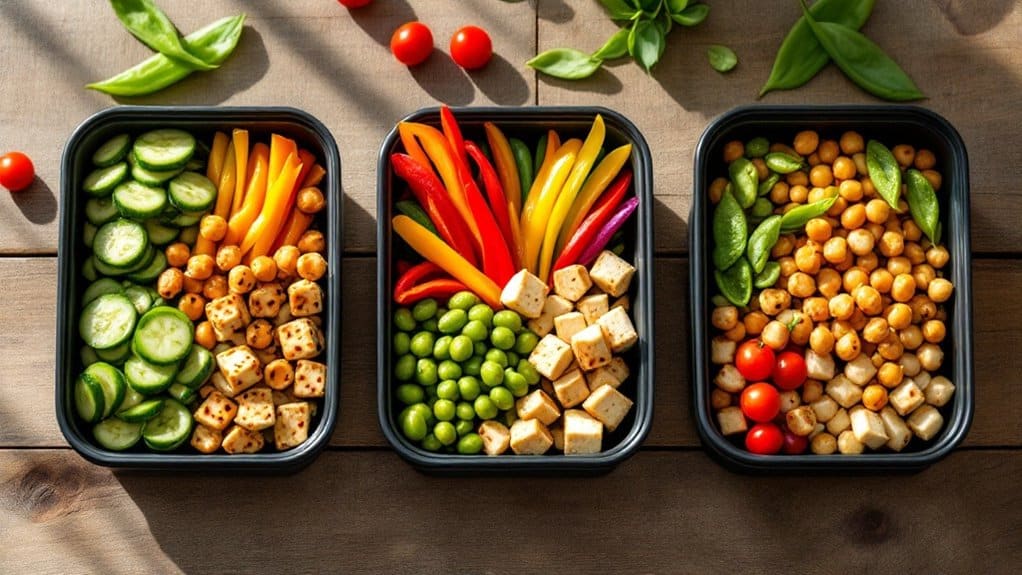Creating blood sugar-friendly Passover desserts requires strategic ingredient swaps while honoring traditional dietary laws. Natural alternatives like almond flour and coconut flour and approved sweeteners like stevia and monk fruit can transform classic recipes. Proper measuring techniques and storage methods guarantee success when adapting beloved treats. By combining traditional observance with modern nutritional needs, bakers can craft delicious Passover desserts that keep blood sugar levels stable—and the possibilities are just beginning.
Key Blood Sugar-Friendly Passover Highlights
- Replace matzo meal with almond or coconut flour to create low-glycemic Passover baked goods that stabilize blood sugar.
- For Passover-approved desserts without glycemic spikes, use natural sweeteners like stevia, monk fruit, or date syrup instead of sugar.
- Measure sugar substitutes by weight and start with 1/3 to 1/2 of regular sugar for accurate results.
- Combine protein-rich ingredients with fiber-rich alternatives to slow carbohydrate absorption and promote steady blood sugar levels.
- Store homemade Passover baked goods in airtight glass containers. Consume them within three days, or freeze them for longer preservation.
Understanding Passover’s Dietary Guidelines for Blood Sugar Management
Managing blood sugar levels while adhering to traditional dietary restrictions can feel like solving a complex puzzle during Passover. The eight-day festival brings unique challenges for those monitoring their glucose, as many conventional recipes rely heavily on matzo meal and potato starch.
Passover traditions require eliminating chametz (leavened grains), typically forcing people to seek alternatives that can spike blood sugar. However, understanding these dietary restrictions opens doors to creative solutions using naturally low-glycemic ingredients.
While Passover’s chametz restrictions present challenges for blood sugar control, exploring low-glycemic alternatives helps maintain both tradition and health.
The key lies in balancing traditional observance with modern nutritional needs. Natural alternatives like almond flour, coconut flour, and ground quinoa (permitted by specific communities) can transform traditional recipes into blood-sugar-friendly versions without sacrificing the holiday spirit.
Smart substitutions make it possible to honor both health and heritage simultaneously.

Natural Blood Sugar-Friendly Passover Alternatives
When preparing Passover-friendly desserts and baked goods, selecting the right sweetener becomes a thoughtful process beyond just finding kosher certification.
Natural sweeteners align beautifully with Passover guidelines while supporting balanced blood sugar levels.
Pure stevia leaf extract, derived from the stevia plant, offers a zero-glycemic option that’s perfectly acceptable for Passover use.
Monk fruit sweetener, another excellent choice, provides natural sweetness without affecting blood sugar levels.
Date syrup, a traditional Middle Eastern sweetener, holds special significance during Passover.
It’s permissible and adds rich caramel notes to baked goods while providing beneficial minerals and fiber.
For those seeking familiar tastes, pure maple syrup and raw honey – when certified kosher for Passover – create delicious results while honoring ancient traditions.
Converting Traditional Passover Recipes to Low-Glycemic Options
Although converting beloved Passover recipes to low-glycemic versions may seem challenging, the process becomes remarkably straightforward with the right ingredient substitutions.
Simple swaps like almond flour instead of matzo meal can dramatically lower the glycemic impact while enhancing nutrition.
Replacing traditional matzo meal with nutrient-rich almond flour creates Passover dishes that are both lower in carbs and higher in healthy fats.
Traditional favorites like coconut macaroons can be reimagined using sugar alternatives and unsweetened coconut.
The key is maintaining familiar textures while reducing carbohydrate content.
Even dense, fruit-based desserts can be transformed by selecting naturally sweet ingredients like figs or dates in moderation.
Intelligent portion control and strategic ingredient substitutions allow families to honor tradition while embracing healthier choices.
Many find that these adapted recipes become new favorites, proving that dietary mindfulness and holiday celebrations can coexist beautifully.
Essential Low-Glycemic Flours and Starches for Passover
The foundation of successful low-glycemic Passover baking lies in selecting the right combination of kosher-for-Passover flours and starches.
Nature provides excellent alternatives to standard matzo meal for those seeking to maintain stable blood sugar levels while honoring tradition.
When properly certified, these nutrient-rich options offer superior glycemic control:
- Almond flour – A protein-packed foundation that creates moist, tender baked goods
- Coconut flour – Naturally sweet with high fiber content for blood sugar stability
- Potato starch – A versatile binder that helps achieve perfect texture
These alternatives not only support balanced blood sugar but also introduce new dimensions of flavor to traditional Passover favorites.
While some may miss the familiar taste of matzo-based treats, these wholesome substitutes often create even more satisfying results.
Baking Science: Balancing Sweetness Without Spiking Blood Sugar
Mastery of Passover baking requires a deep understanding of how different sweeteners interact with kosher-approved ingredients.
The baking chemistry behind natural sweeteners like monk fruit, stevia, and allulose creates unique challenges when developing blood sugar-friendly desserts.
Success lies in the flavor balance between sweetness and other taste elements. For example, adding cinnamon or vanilla can enhance perceived sweetness while requiring less sweetener. A touch of salt also brightens sweet notes without affecting blood glucose levels.
Balance sweetness naturally by using cinnamon, vanilla, and a pinch of salt to enhance flavor without impacting blood sugar.
Many home bakers find that combining two or more natural sweeteners produces better results than using just one. This strategy helps minimize any unusual aftertastes while maintaining the traditional joy of Passover treats without the sugar spike that follows conventional recipes.
Best Practices for Measuring and Using Sugar Substitutes
Successfully measuring and incorporating sugar substitutes requires a strategic approach, since natural sweeteners vary dramatically in concentration and volume compared to traditional sugar.
Understanding proper sweetener ratios is essential for maintaining recipe integrity while achieving the desired taste.
Key practices for sugar measurement include:
- Start with 1/3 to 1/2 the amount when substituting concentrated sweeteners like stevia or monk fruit
- Account for moisture differences by reducing liquid ingredients when using honey or maple syrup
- Use weight measurements rather than volume for the most accurate results
Experimentation helps determine ideal proportions; each sweetener brings unique properties to recipes.
Many bakers find success by combining multiple natural sweeteners to create a more balanced flavor profile that closely mimics traditional sugar’s characteristics.
This method allows for blood sugar management while preserving familiar taste experiences.
Common Pitfalls to Avoid When Adapting Passover Desserts
While adapting traditional desserts for Passover presents exciting opportunities for creativity, home bakers often encounter several challenging pitfalls that can impact their results.
Common Passover pitfalls include over-mixing matzo meal batters, which can lead to dense, heavy cakes, and using too much potato starch, resulting in gummy textures.
Successful dessert adaptations require careful attention to moisture levels. Many bakers make the mistake of directly substituting Passover-approved ingredients without adjusting liquid ratios. This often leads to dry, crumbly outcomes.
Temperature control proves vital when working with alternative sweeteners and nut-based flours. These ingredients brown more quickly than traditional ones, requiring vigilant monitoring and often lower oven temperatures to prevent burning while ensuring thorough baking.
Storing and Preserving Sugar-Free Passover Baked Goods
Proper storage techniques make all the difference when preserving sugar-free Passover baked goods, which can be remarkably delicate and prone to moisture changes.
Protecting delicate sugar-free Passover treats requires precise storage methods to maintain their texture and prevent moisture damage.
Without traditional sugar acting as a preservative, these treats require special attention to maintain their freshness and integrity.
For ideal sugar-free storage and extended shelf life, follow these essential preserving techniques:
- Store items in airtight glass containers rather than plastic, which can trap unwanted moisture and compromise texture.
- Baked goods wrapped individually in parchment paper can be kept at room temperature for up to 3 days or frozen for up to 3 months.
- Label containers with contents and dates, and consider adding a silica gel packet to absorb excess moisture.
Remember that sugar-free items may develop texture changes faster than traditional baked goods, so portion sizes should be planned accordingly.
Recipe Modifications for Classic Passover Desserts
Traditional Passover desserts can be reimagined with natural ingredients while maintaining their cherished flavors and textures.
Classic macaroons become nutrient-rich when made with unsweetened coconut and maple syrup, while flourless chocolate cake transforms beautifully using nut flour and date paste.
Healthy frosting alternatives open up new possibilities for decorated holiday cookies and cakes.
Whipped coconut cream provides a delightful dairy-free option, while pureed dates and cashews create rich, creamy toppings that everyone can enjoy.
The beloved chocolate-covered matzo takes on new life with dark chocolate and a sprinkle of sea salt.
Even traditional sponge cake rises to the occasion when made with almond flour and natural sweeteners, proving that dietary restrictions need not limit holiday joy.
Natural Blood Sugar-Friendly Passover FAQs
Can Diabetic Children Eat Regular Matzah During Passover?
Children with diabetes should monitor matzah intake due to its high glycemic impact. Exploring matzah alternatives and diabetic-friendly recipes allows them to participate while maintaining blood sugar control during Passover.
How Long Does It Take for the Body to Adjust to Sugar Alternatives?
Like clockwork gears shifting, the body typically needs 2-4 weeks to overcome sugar cravings and complete its adjustment period when changing to sugar alternatives, though individual experiences may vary.
Are Natural Sugar Substitutes More Expensive Than Traditional Passover Baking Ingredients?
Natural sweeteners often carry higher upfront costs than regular sugar. However, budget-friendly alternatives like stevia plants, monk fruit, and bulk purchases can help offset expenses over time through mindful shopping.
Which Kitchen Tools Are Essential for Successful Low-Glycemic Passover Baking?
Essential baking tools include digital scales for precisely measuring low-glycemic ingredients, silicone mats, non-stick pans, mixing bowls, stand mixers, and fine-mesh strainers for achieving ideal texture and consistency.
Can I host a Server if guests have different blood sugar management needs?
Thoughtful seder planning allows hosts to accommodate guests with varying blood sugar needs. Offering diverse dietary accommodations guarantees everyone can participate fully while managing their health requirements comfortably and safely.
To Sum it Up
With these tools and techniques for blood sugar-conscious Passover baking, the possibilities are truly endless. Gone are the days of settling for bland, sugar-laden desserts that skyrocket glucose levels. Whether crafting cloud-like macaroons or reinventing traditional matzo recipes, bakers can now create show-stopping holiday treats that honor tradition and health. The sweetest part? These natural adaptations often taste even better than their conventional counterparts.









